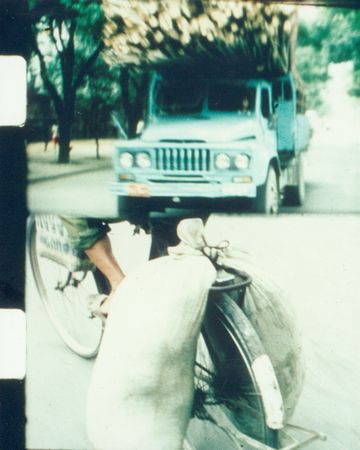Expression, oppression innovation
  |
|
Film stills and video clips the exhibition from From Experimental Film to the Audiovisual Vanguards. Photos: Courtesy of Miguel de Cervantes Library |
Until July 31, a series of Spanish experimental films and audio videos made over the past 80 years is being shown in the city. Called From Experimental Film to the Audiovisual Vanguards, the movie exhibition is being held at the Miguel de Cervantes Library in the Cultural Department of the Spanish Consulate in Shanghai. The Spanish curator, Xavier Garcia Puerto, told the Global Times that it is the first time these works have been shown in Shanghai. "For some, it is even the first time they have been shown in Asia," he said. "The whole exhibition is divided into four sections based on different developmental stages of Spanish experimental films from the 1920s to recent years, and through the projection of these works, you will see not only the evolution of Spanish movies, but also the changes in the social environment of Spain."
From Dalí to today
For the first time in Asia, the essential Un Perro Andaluz (An Andalusian Dog), a 15-minute silent film produced in 1929 by Luis Bu?uel, one of the most influential directors of all time, and Salvador Dalí, one of the most talented artists of all time. Both also appeared in the film. "It is a typical surrealist film. The film contains no complete story, but consists of countless separated pictures without any continuity among them. And most of the pictures in the work have a huge visual impact so that you might be confused whether you are in reality or have fallen into the surreal world that the creators made for you," Garcia Puerto said. "In fact, in Un Perro Andaluz, groups of ants always appear, which also appear in other films Dalí collaborated on at that time. It was just the kind of animal which often appeared in Dalí's dreams when he was a child, and he mentioned that in his autobiography."
Garcia Puerto went on to add, "Although the social environment was volatile because it was the time between the World War I and World War II, artists like Salvador Dalí and Luis Bu?uel, still experimented with the 'new' cinematography, like the French vanguard representatives, Man Ray, Duchamp and Hans Richter. And in that period, film became freer and different from other art forms."
Aside from three surrealist films from the 1920s to 1930s, other contemporary works from throughout the 20th century are also included in this exhibition. One section titled Del éxtasis al arrebato covers the works of José Val del Omar, who was a pioneering Spanish filmmaker and inventor during the 1950s, experimental filmmaker José Antonio Sistiaga, known for hand painting images directly onto film stock, Iván Zulueta, a key figure of the La Movida Madrile?a (a countercultural movement that took place mainly in Madrid in the 1970s), and Pedro Almodovar, the most successful and influential Spanish filmmaker of his generation.

Creativity under tyranny
Garcia Puerto told the Global Times that because of Francisco Franco's dictatorship (1939-1975) in Spain, creative acts were not advertised unless they were pro-government and the trends that were popular in Europe reached the country in pieces leaving most Spanish artists to be left to their own devices. "The best-known artists at this time, José Val del Omar, José Antonio Sistiaga and Iván Zulueta were very isolated, and their works are always related to religion, political fear and sexual repression."
In José Val del Omar's Fuego en Castilla (Fire in Castile), many religious statues appear on the screen under veils and appearing transparent. "The creator was obviously a virtuous stylist whose application techniques, superposition, and time-lapse mastering over the veils, deepen the symbolism and the captivating power of the images, driving us through a lyricism that is almost mystical," he explained.
Entering the 21st century, a new generation of auteurs began to explore the boundary between traditionally defined film works and video art. They also tried to break the boundary between the creator and the audience. These works are all exhibited in the section named Videonautas and elmur.net. "These creators no longer consider what film really is, and they do what they want. This also shows a more and more open social environment in Spain," Garcia Puerto said.
According to the curator the 110 pieces shown in this exhibition are mostly unedited. "Through these original works, we expect audiences can contextualize this grand creative corpus on the history of Spanish film and of contemporary creations, and rediscover something about their own surrounding environment."
 0
0 







Go to Forum >>0 Comments